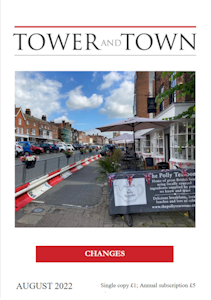

Tower and Town, August 2022 (view the full edition) (view the full edition)The Wonderful Names Of Our Butterflies
I am the author of a book about the strange names of British butterflies and moths called Emperors, Admirals and Chimney Sweepers (Little Toller, 2020). The first thing to understand about butterfly names is that they are not recent. Apart from the butterfly of that name, you probably last came across the word 'ringlet' in the works of Jane Austen! It all seems to have begun around 300 years ago. Before that, it seems our butterflies had no names at all: they were just 'butterflies', whether brown, white, blue or multi-coloured. In different places there might have been local names, but, if so, unfortunately no one wrote them down. The naming of butterflies was the task of the world's first society devoted to the study of insects, the London-based Society of Aurelians, which flourished in the 1730s and 40s (before their premises were burned down in a fire in 1749). Many of the Aurelians were artists, and their books about butterflies were indeed works of art, full of luscious and expensive hand-coloured plates. Perhaps that is why many butterfly names are about colour. Clouded Yellow (photo left), for instance, is perfect for a butterfly which is saffron yellow with dark, cloudy smudges.
As for Red Admiral, it has nothing to do with a senior rank in the Royal Navy. If you say 'admirable' fast, it tends to come out as 'admiral'. That is what it is: a Red 'Admirable'. Its relative, the Painted Lady, evokes seventeenth century make-up; rouge, flesh tints and thick black mascara, just like the butterfly. Its even older, possibly Europe-wide, name was 'Bella Donna' - pretty lady.
 Peter Marren |